Iris, Dres ma དྲེས་མ
Dres ma (Tibetan)Cherachi (Ayurveda)
Ku Men Yuan Wei (TCM)
 Iris bulleyana
Iris bulleyanaW.R. Dykes, The genus Iris, (1912)
 Iris lactea
Iris lacteaAnnales de flore et de pomone, (1817)
 Iris kemaonensis
Iris kemaonensisCurtis’s Botanical Magazine (1887)
 Iris bulleyana
Iris bulleyana(Photo by peganum) (Wikimedia)
Botanical name:
Iris spp.
There are four types recognised in Tibetan Medicine:
- Mo dres མོ་དྲེས ‘Male’: Iris bulleyana, I. ensata (Xi Nan Yuan Wei, TCM)
- Pho dres: ‘Female’ Iris lactea (syn. I. triflora), I. kemaonensis (I. kingiana)
- Ma ning dres ma མ་ནིང་དྲེས་མ ‘Neuter’ Iris goniocarpa, I. lactea var. chinensis, I. potanini
- Dres mai ge sar དྲེས་མའི་གེ་སར་: Iris collettii
Parts used:
Root; whole plant (also flower and seed)
Temperature & Taste:
Neutral, Sweet, Pungent, Bitter
Uses:
ROOT, WHOLE PLANT:
1. Clears Wind-Heat, Resists Poison:
-disorders from microorganisms
-general for Poison
-Wounds
-has also been used for Tinnitus
2. Clears Damp, Promote Urine:
-disorders due to Serous fluids (Damp)
-root and leaf are diuretic, used for Edema
-Urinary and Kidney disorders
3. Clears Phlegm, Stops Cough:
-Cough, Bronchitis
-Catarrhal deafness
4. Purges Phlegm:
-gently purges phlegm and damp
5. Externally:
-Powder is applied to Acne, Sores
-root powder with honey is applied to freckles and dark spots
-root ashes applied with fat turns white hair black
-ashes applied to wounds dries up pus and serum
-Scabies, Urticaria
SEED:
1. Kills Worms:
-used for Worms (Seed)
-Colic pain due to Worms
2. Moves Qi:
-used for Hot and Cold disorders of the Stomach
-Colic
-pain in the Chest
3. Clears Wind-Heat, Resists Poison:
-Cough and Cold, Fever
-antidote to Opium addiction (Ayurveda)
FLOWERS:
1. Tinnitus
2. Poor or failing Eyesight.
3. Relieves pain
Dose:
Powder: 1–3 grams
Substitute:
1. Iris humilis (syn. I. flavissima, I. arenaria)
2. Orris root in some instances
Main Combinations:
1. Sudden deafness or Tinnitus, Iris Dres ma with Incarvillea, Safflower, Caraway
Major Formulas:
Cautions:
None noted
